(Upper Sacramento River, Shasta and Tehama counties)
Species / Location
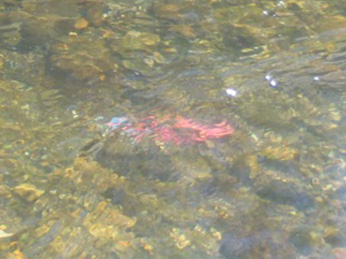
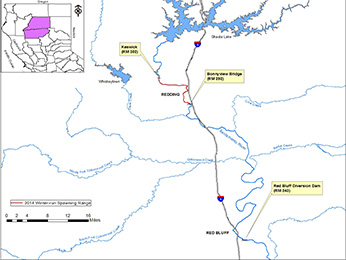 Figure 1. Location of 2014 Winter-run spawning range and survey reaches on the Sacramento River.(click/tap to enlarge)
Figure 1. Location of 2014 Winter-run spawning range and survey reaches on the Sacramento River.(click/tap to enlarge)
Sacramento River winter Chinook salmon (winter-run) are one of four distinct runs of Chinook salmon in the Sacramento River watershed. Winter-run are genetically diverse and endemic to the upper reaches of the Sacramento River. Historically, these fish were abundant in the McCloud River where they spawned in the cold, glacial spring waters of Mt. Shasta. The completion of Shasta Dam in 1943 eliminated the migration of winter-run to their native spawning grounds which led to their decline. Today, winter-run are federally and state listed as endangered species and migrate upstream only as far as Keswick Dam near Redding California (Figure 1). Keswick Dam, 9.5 miles downstream of Shasta Dam, is the uppermost limit to migrating salmon on the main stem Sacramento River.
Need for Drought Stressor Monitoring
Water years 2013 and 2014 (October 1 for any given year through September 30, of the following year) were two of the driest years on record in California (DWR, 2014). California declared a state of emergency due to the long term drought and established water conservation and monitoring measures.
Stressor Monitoring Efforts
Enhanced winter-run monitoring was initiated July 2014 as part of the Drought Operations Plan and associated winter-run contingency plans. The enhanced monitoring focused on identifying and measuring winter-run salmon nests or “redds”, and measuring water temperatures throughout the spawning grounds to determine if winter-run egg and juvenile survival was impacted by warm water temperatures. Efforts by CDFW and PSMFC staff included deployment of multiple water temperature recording probes every two miles from Red Bluff Diversion Dam to Keswick Dam, a distance of 60 miles. Other probes measuring dissolved oxygen were deployed near active winter-run redds. Additionally, crews measured shallow water redds and conducted multi-month monitoring and modified several of these shallow winter-run redds to prevent dewatering as river flows were reduced to conserve water.
Findings
Beginning July 18, 2014 crews deployed multiple loggers to measure water temperature and dissolved oxygen in the upper river. Preliminary findings suggest that river water temperatures exceeded the ideal maximum 56 degree Fahrenheit level for salmon survival during the egg and alevin (hatchling salmon) periods in early September through early November impacting winter-run egg and juvenile survival. Analysis of this impact is ongoing. Dissolved oxygen levels did not appear to be impacting survival during preliminary analysis.
From June 6 through November 7, 2014, a total of 32 winter-run redds were closely monitored for dewatering immediately following Keswick flow release reductions. Winter-run redds were identified and located using both aerial redd and boat surveys. All of the monitored winter-run redds were located near Redding between Bonnyview bridge (RM 292) and Keswick Dam. Each redd was marked with a unique numbered marker (Figure 2) and data was collected (GPS location; water depth in inches from top of tailspill to water surface; and water velocity). All marked redds were revisited and measured after each flow release reduction from Keswick Reservoir.
During September 2014, the CDFW adopted a redd modification protocol in order to reduce the impact of future winter-run redd dewatering (see Figures 3 and 4). This protocol was designed to assist with the emergence of stranded fry in redds at risk of being dewatered. This was considered as a “last-ditch” effort to increase the opportunity for juvenile winter-run to emerge from redds that were going to be dewatered by imminent flow reductions and allowed at least a possibility of survival for fry in the redds that become dewatered (see Figure 5). This emergency effort involved gently removing several inches of rock by hand from the tops of eight shallow-water redds to allow increased flow over the top and sides of the redd (Figure 4). Juvenile winter-run fry were observed emerging from a dewatered one redd during the modification process.
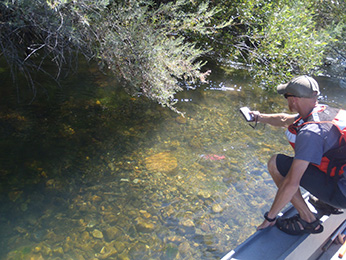 Figure 2. Crews monitoring a winter-run Chinook salmon redd in shallow water after a flow reduction on the Sacramento River.
Figure 2. Crews monitoring a winter-run Chinook salmon redd in shallow water after a flow reduction on the Sacramento River.
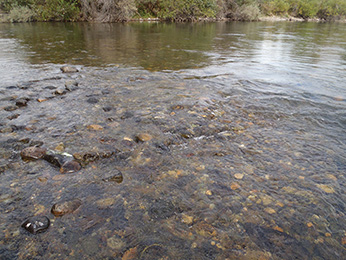 Figure 3. Example of a winter-run Chinook salmon redd nearly dewatered after flow reductions in the Sacramento River.Redd modification would remove just enough substrate to allow water flow over top of redd after any further flow reductions.
Figure 3. Example of a winter-run Chinook salmon redd nearly dewatered after flow reductions in the Sacramento River.Redd modification would remove just enough substrate to allow water flow over top of redd after any further flow reductions.
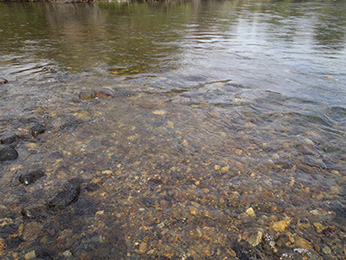 Figure 4. Example of a winter-run Chinook salmon redd after redd modification. Some upper substrate has been removed (see Figure 3 for comparison) and water will continue to flow over redd after a flow reduction.
Figure 4. Example of a winter-run Chinook salmon redd after redd modification. Some upper substrate has been removed (see Figure 3 for comparison) and water will continue to flow over redd after a flow reduction.
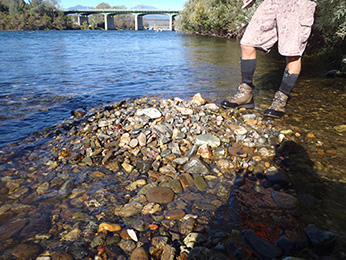 Figure 5. Example of a winter-run Chinook salmon redd dewatered after flow reductions in the Sacramento River in 2013. Note that redd modifications were made to avoid similar situations in 2014.
Figure 5. Example of a winter-run Chinook salmon redd dewatered after flow reductions in the Sacramento River in 2013. Note that redd modifications were made to avoid similar situations in 2014.
Future Efforts
CDFW sees the biological need to continue to monitor Chinook salmon redds and water quality conditions. At this time, no funding is secured for this work, and whether future monitoring will occur is uncertain.
References
CDFW
Pacific States Marine Fisheries Commission